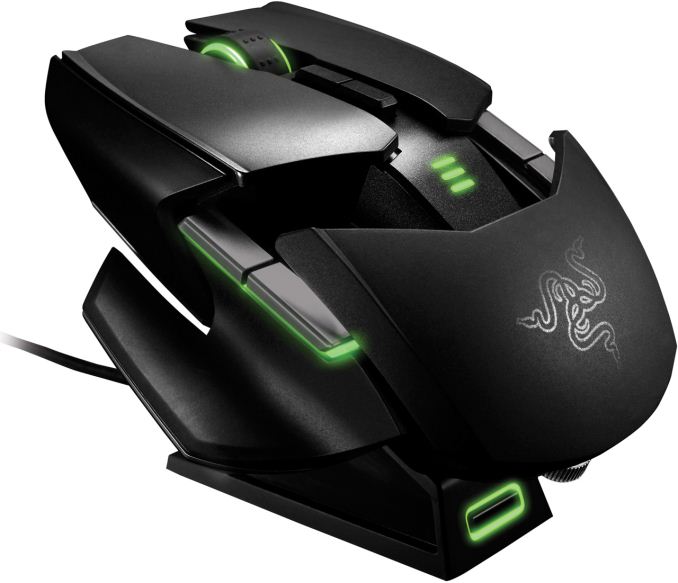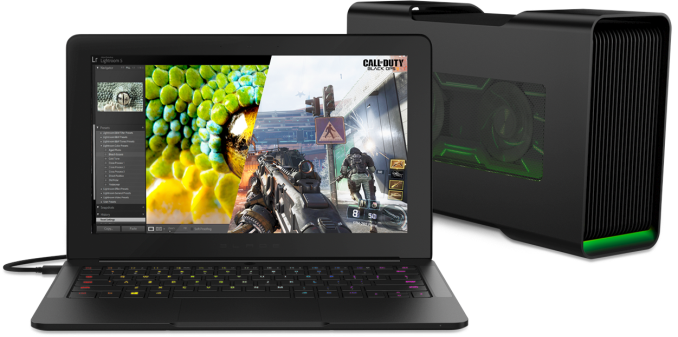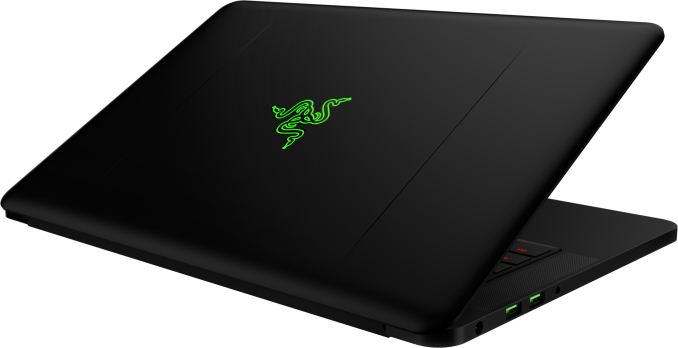Razer Files for IPO in Hong Kong to Raise $600 Million
by Anton Shilov on July 8, 2017 11:00 AM EST- Posted in
- Peripherals
- Systems
- Razer
- THX
- Nextbit

This week Razer has made a preliminary filing for IPO on the Hong Kong Stock Exchange. The company plans to raise $600 million for future growth, particularly in Asia. In addition, the funding is supposed to improve the company’s overall march with investments in R&D as well as the brand. Razer's recent financial filings indicate Razer operated at a $20m profit in 2012-2013, but ran a loss of ~$70m in 2015-2016 because of multiple acquisitions as well as a tripling in R&D activities with a small uptick in revenue.
Razer started as a subsidiary of a computer peripheral maker Kärna in 1998 and quickly became famous for its Boomslang mouse designed specifically for FPS gamers and launched in 1999. Kärna ceased to exist in 2000 because of financial issues, but the Boomslang was so popular despite its price tag (which was high by the standards of the year 2000) that Terratec brought the Razer Boomslang back to market in 2003. Min-Liang Tan and Robert Krakoff (who used to be the GM of Kärna back in the day) acquired rights to the IP and the brand sometime in 2005 and established Razer Inc., as we know it today. Initially, Razer focused on mice, but the company gradually expanded its product portfolio with keyboards, headsets and other peripherals. Sometime in 2009-2010, Razer began to hire engineers from PC companies like Dell and HP with an aim to develop actual systems and go beyond peripherals. Today, the company offers various gaming gear, laptops, co-developed Razer Edition PC systems, and licenses its designs to others. Meanwhile, Razer is always in pursuit to expand its lineup of products and their distribution.
The company actively develops various concept devices that may or may not become big. Over the past years, Razer has demonstrated its Switchblade console, the Christine modular PC concept, the Valerie triple-display notebook, the Ariana projector and other devices: none of which have ever hit retail production. In addition, they have acquired multiple companies, including Ouya, THX, Nextbit and others, to expand its IP portfolio. Finally, to drive sales, Razer started to open its own stores in the U.S. and Asia in 2015–2016. R&D efforts, acquisitions, and stores all require money, which is why Razer went from a $20.332 million profit in 2014/15 to losing $20.356 and $59.332 million in successive years. Over that time, Razer’s revenues have increased from $315.2 million in 2014 to $392.1 million in 2016, clearly indicating growing demand for gaming hardware and peripherals as well as Razer’s success.
Razer’s latest round of $50-$100 million venture capital investment in May valued the supplier at approximately $2 billion, reflecting investors’ confidence in the company. Apparently, to keep evolving, Razer needs more money and with its IPO on the Hong Kong Stock Exchange the hardware supplier plans to raise up to $600 million, reports TechCrunch.
One of the things that Razer wants to do is to expand in Asia. At present half of the company’s revenue comes from the U.S., the remainder is split between Asia and Europe. Since the Asian/APAC market is very large and has a high potential, the company has good chances to increase its revenue, particularly in countries like China and Taiwan.
Another potential area for growth is gaming PCs. In 2016, the company generated 76.2% ($298.8 million) of its revenue from gaming peripherals, whereas PCs accounted for only 23.1% ($90.1 million). Owners of Razer’s mice and keyboards tend to be loyal customers and if the firm manages to offer them the right computers, they could bite, driving Razer’s revenues up. More recently Razer jumped into services and digital currency businesses, but have yet to become significant revenue sources for the balance sheet.
Wrapping things up, it is evident that Razer is growing fast as a result of overall industry trends, as well as competitive products and brand recognition. With additional funding, the company could unlock more growth opportunities, but Razer is tight-lipped what it plans to do with the IPO.
Related Reading
- Razer Announces Project Ariana: Chroma Lighting Comes To The Room, And To Third Parties
- Razer Reveals Their Triple Monitor Gaming Laptop Concept: Project Valerie
- Razer Acquires Majority Of THX Ltd Assets
- Razer Updates The Razer Blade Stealth: More Screen, Less Bezel, New Color Option
- Razer Launches The Thresher Ultimate: An Xbox, PS4, And PC 7.1 Headset
- Razer Announces The Lancehead Gaming Mice
- Razer Updates The Razer Blade Pro With THX Certification
Source: TechCrunch













24 Comments
View All Comments
Tams80 - Wednesday, July 12, 2017 - link
Only CMYK LEDs will do that!bill.rookard - Saturday, July 8, 2017 - link
Any company that's been in business for the most part for 20 years isn't doing too badly, and that means they've been doing things longer than... Google?Death666Angel - Saturday, July 8, 2017 - link
"Razer started as a subsidiary of a computer peripheral maker Kärna in 1998 "So, they started after Google. Please get your facts straight. Idiot.
WorldWithoutMadness - Saturday, July 8, 2017 - link
Mmm... something have to do with phone business (the Nextbit thingy)? I can't think of anything else except that needing lots of capital. RGB Blingbling Phone 24 hours connected to SynapseMamiyaOtaru - Saturday, July 8, 2017 - link
mice: Deathadder is the best. Dunno about the rest.I would love to get one of their laptops (love the look, pretty understated actually) but that battery life :( I mean I get it with the ones with a GTX inside (even with Optimus? eh) but there's no reason the Stealth should have less than half the battery life of an XPS 13 :(
BrokenCrayons - Monday, July 10, 2017 - link
As the owner of a Deathadder, I can safely say the mouse works correctly as long as you don't install Synapse software. Once I did that, my PC regularly failed to recognize it on boot up which required a power cycle or two in order to correct. Windows native mouse drivers worked fine. Obviously you can't configure it or do anything with the LEDs, but at least it functions reliably.The only problem is that it's absolutely _not_ any better than any cheap mouse I've used. There's no secret sauce, no magic bullet, or any unexplained improvement in my point and click experience that made it worth the price over the $14 wireless Logitech and/or the free-with-the-PC Dell branded mouse that were in place before it. There's no less input latency and the wireless Logitech was a bit easier to use since it wasn't chained to the USB port via a cable. It feels nice in the hand, but beyond that it's yet another mundane interface device in a sea of much cheaper, equally functional alternatives.
Stuka87 - Monday, July 10, 2017 - link
When was the last time that you tried Synapse? I have a Razer KB and Mouse and have never had a single issue with the software.The fact that you can't tell the difference between a super low DPI mouse and a super high DPI mouse shows you most likely do not play games that require high precision. Nothing wrong with that, but your statement saying that there is no difference is wrong.
There is a difference in latency (ESPECIALLY when it comes to a wireless vs wired), the Razer has dual sensors (assuming its not an older model) and are much higher resolution.
BrokenCrayons - Monday, July 10, 2017 - link
It's a Chroma RZ01-0121 I picked up less than 6 months ago and I last had Synapse installed about 2 months ago. There is no difference at all in mouse responsiveness in anything I do. From poking around in the UI to playing a FPS, it felt and acted just like any other mouse (yes, I messed extensively with the settings in Synapse). It was a little more comfortable to hold than my Logitech M187 that I keep in my laptop bag, but that came down to ergonomics. The 10000 DPI sensor for all its proclaimed precision just ended up being a sales gimmick and I can't rationalize trying to convince myself and others that I made a good purchase decision just to feel better about it. The Deathadder was a waste of money and I'm not going to try to pretend like it's anything other than another ho-hum been-there-and-done-that mouse except it's tied to a really awful piece of software. Claiming anything else based on my personal experiences would be a lie.tipoo - Monday, July 10, 2017 - link
Yeah, battery optimization seems to be an area smaller companies often suffer on, unfortunately.
Does the new 2017 Stealth with the slimmer bezels still have that poor battery life?
Barilla - Monday, July 10, 2017 - link
Razer: Great design, bad software, terrible quality.That's about their mice / keyboards, can't speak for other products.